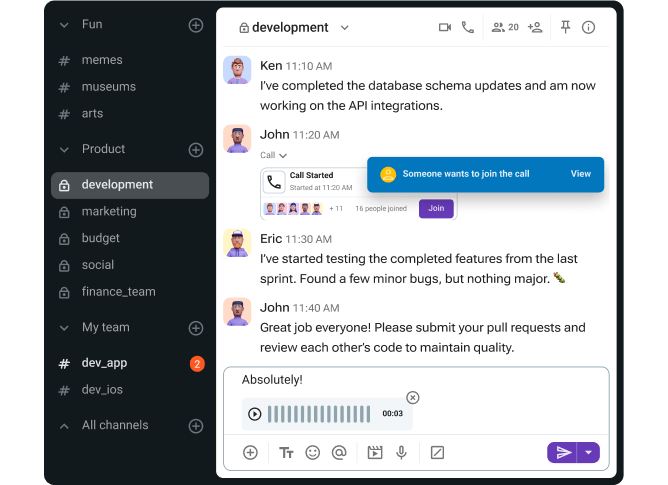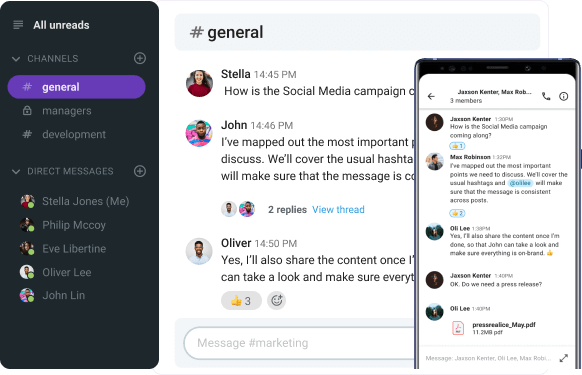News travels fast — especially in the workplace. But which direction will it take?
The stream of business communication can flow in two distinct channels — formal and informal. Grapevine communication is just a different name for informal communication — it doesn’t matter whether it’s work-related or not. And without official channels to regulate informal discussions, the rumor mill runs wild.
Try as you might, you can’t eliminate grapevine communication. It will continue to occur for as long as we have to collaborate and communicate with one another.
The solution, then, is to accept this inevitable phenomenon and learn how to manage it. This is exactly what this article will help with as we try to answer questions such as:
- Why do rumors start in the workplace?
- What are some examples of grapevine communication?
- How can leaders use the grapevine?
Let’s dive in.

- Grapevine communication is an informal way of communicating within an organization. The word “grapevine” refers to the fact that information spreads in all possible directions. Many informal and formal communication processes can trigger the grapevine, including promotions, mergers, takeovers, and layoffs.
- Despite the existence of formal communication channels, the grapevine is typically most active at the lower levels of an organization. However, if the formal channels are ineffective or transmit ambiguous information, the grapevine will produce more intense rumors.
- It’s important to remember that it’s not possible to completely wipe out grapevine communication from your workplace. Instead, a more feasible approach involves managing the grapevine so that it leads to more positive communication outcomes.
- Reining in the grapevine entails establishing yourself as a credible source of information through your employee communication app, as well as building trust and transparency.
Table of Contents
What is grapevine communication?
Grapevine communication is an informal type of social interaction in the workplace, during which formal information may be exchanged unintentionally.
This formal information is not necessarily something that should remain private. Rather, it may include details you may expect to hear from formal communication channels during the process of downward communication (i.e., an executive sharing a company-wide announcement).
In line with it being informal, grapevine communication doesn’t follow a predetermined set of rules — it can happen during chit-chat, instant messaging, phone calls, and more. In short, all instances of organizational communication that are informal fall under the grapevine umbrella.
But is the grapevine good or bad for the company?
Well, in theory, informal conversations aren’t bad by default. It’s just that they can have detrimental consequences when they emerge as a reaction to a lack of formal communication.
And, like most types of communication, grapevine communication doesn’t happen in a straight line, and we can categorize it into several distinct subtypes.
💡 PUMBLE PRO TIP
Informal communication can take the form of the grapevine, which can lead to less than formal workplace conversations. To learn why formal communication matters and how it differs from informal communication, check out this blog post:
The four types of grapevine communication
According to the division by Prof. Keith Davis — the most widely used categorization — grapevine communication comes in 4 flavors:
- Single strand chain,
- Gossip chain,
- Probability chain, and
- Cluster chain.
Here’s more detail about each.
#1 Single strand chain
Imagine the following scenario: your cubicle neighbor is getting up to make coffee. You know that they need to walk by the finance department, so you tell them to pass a message along to the accountant.
That’s how the single strand chain subtype of grapevine communication functions — instead of relying on email or anything even remotely formal, you employ an informal courier to pass the message from one person to the next.
As the example below shows, the same scenario can unfold in an instant messaging app, too.
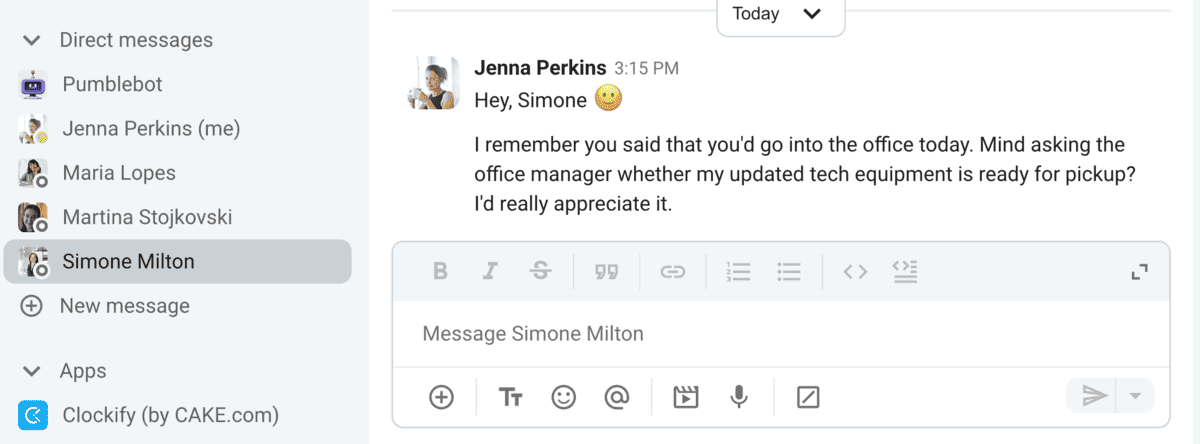
However, it’s important to note that the information can pass through more than one pair of hands before reaching the intended recipient.
The more people you include in a single strand chain, the more it all begins to look like a game of Telephone. A secret message is whispered through a single strand chain, and hilarity ensues when the final recipient says aloud the contents of the message they received.
And just like in the game, the more players there are in your communication process, the higher the likelihood of the message getting warped before reaching the final recipient.
#2 Gossip chain
Gossip chains are the easiest to imagine — we all know how gossip works.
This subtype of grapevine communication is characterized by a single person who relays all the latest info to their coworkers.
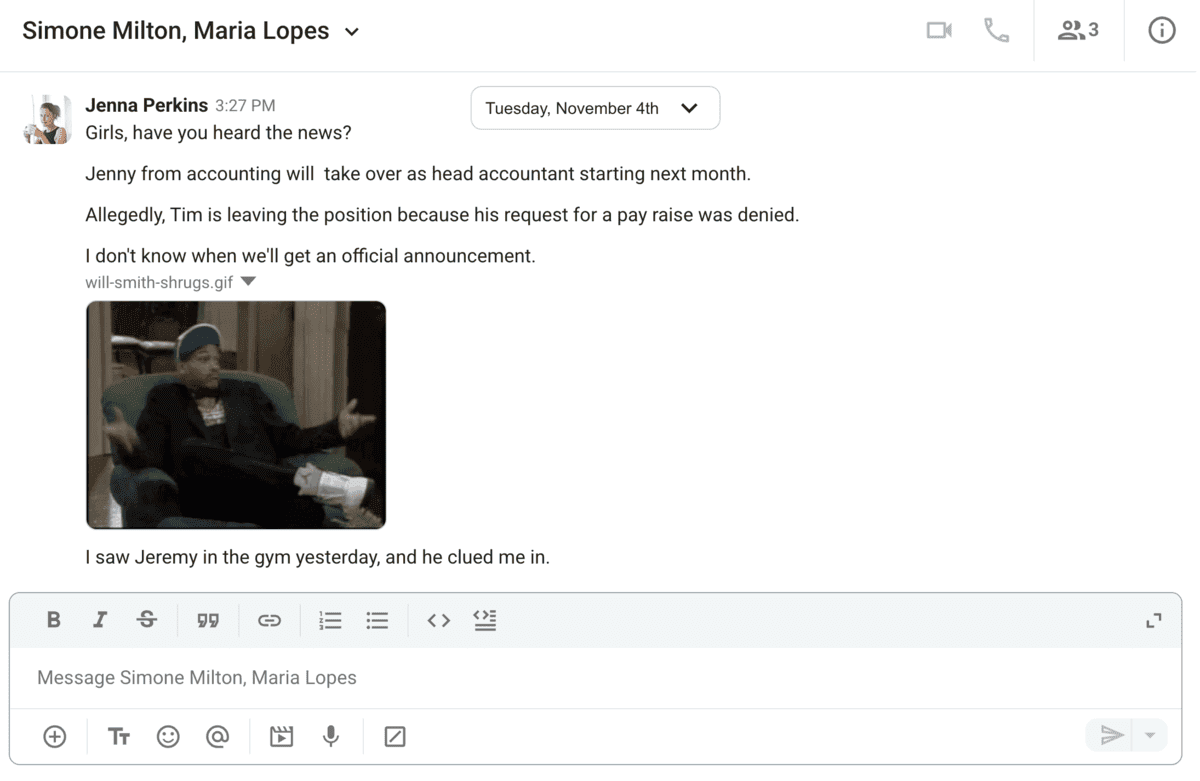
It’s important to mention that the information spread by gossip isn’t always negative. Even though the word “gossip” doesn’t exactly carry positive connotations, gossip chains are only characterized by their epicentral nature whereby information spreads indiscriminately to everyone from a single direct source — it has nothing to do with the content of the information.
According to Kurland and Pelled, what separates positive gossip from negative gossip is that it doesn’t give the gossiper coercive power. In fact, as an integral part of interpersonal communication, gossip can sometimes even spark creativity by bringing forward new ideas — as long as you don’t get swept up in unnecessary rumors.
💡 PUMBLE PRO TIP
As we’ve mentioned, gossip isn’t necessarily a prime example of negative communication, but you should still stay vigilant. For a better understanding of how positive and negative communication can affect team dynamics, head to this blog post:
#3 Probability chain
Probability chains are by far the most difficult to conceptualize because there’s no method to their madness — they are governed by the laws of probability alone, making them completely random in nature.
For example, let’s say you ask a coworker whether they’ve done something interesting during the weekend, and they inform you that they — for whatever reason — watched this amazing documentary on beaver dams. This is the kind of irrelevant information that probability chains deal in.
In any case, you receive this info and then you go on about your work, knowing that this documentary is out there. If the context in which you could share this information arises, you will share it, but there’s no way to predict this. Likewise, the other people you inform about the documentary may then go on to spread the word further, again completely randomly.
Thus, probability chains are the rarest form of grapevine communication in the workplace, and the one least likely to concern the employer.
#4 Cluster chain
Remember the ALS Ice Bucket Challenge? This phenomenon is a perfect example of a cluster chain.
It functioned like this: you film yourself pouring a bucket of ice-cold water on yourself to spread awareness for ALS (a nervous system disease that affects nerve cells in the brain and spinal cord). You nominate (in most cases) 3 other people to do the same. The nominated people who rise to the challenge also nominate 3 people they know, and so on.
Mathematically speaking, only 15 iterations of this challenge would be enough to include over 14 million people.
Of course, these numbers aren’t something you have to worry about within your team, but the basic principle is the same. Perhaps the boss will share some information with team leaders and expect them to pass that info on to a select few employees.
This sometimes occurs with recruiting and hiring. If the company wants to hire a new employee for a certain position, HR might reach out to employees most likely to know the relevant people and ask them to spread the word.
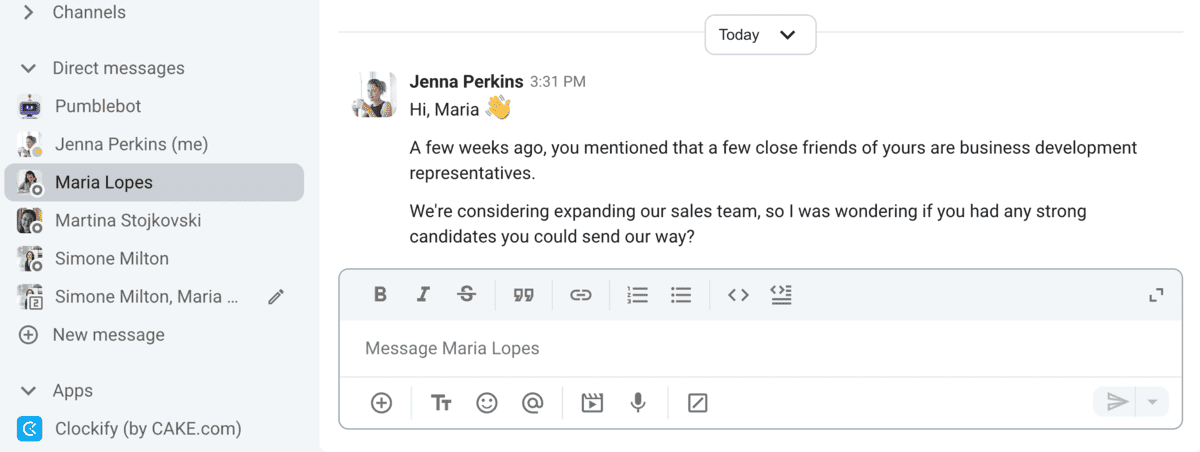
We may also look at cluster chains as a different type of gossip, where we don’t have a single person spreading the word to everyone. Instead, people spread the word only to a select few individuals, who then relay the information to their select few, and so on.
Now that we’ve covered several examples of grapevine communication, we come to two important questions: why does it happen in the first place and what are its consequences?
Why does grapevine communication occur at work?
Formal channels — like emails, meetings, conference calls, speeches, and handouts — all follow a fixed rule system. These predefined conventions set certain expectations in the workplace, and employees across all levels of the organization are expected to abide by them.
However, a consistent failure to meet these expectations (with insufficient transparency about new changes or silence regarding updated PTO policies, for example) can push the rumor mill at work into overdrive.
This information vacuum leads employees to fall back onto gossip in search of information.
Furthermore, the silence from leadership and management can be interpreted in a negative light, sometimes even leading to:
- A lack of trust in leadership,
- A dip in employee morale, and
- Rampant rumors.
Unfortunately, it seems that some companies have a lot of work to do to catch up with the grapevine. According to data from the AMA (American Management Association), an estimated 70% of all workplace communication travels through the grapevine. Moreover, while nearly all lower-level managers are aware of the activity within the grapevine, it is lost on 30% of upper-level managers.
Because we’re so inclined to communicate through the grapevine while leadership underestimates it, several events can make gossip and rumors more widespread, including:
- Slow and inefficient formal communication,
- Vague change and crisis management communication, and
- Mounting employee stress and frustration.
Optimize communication with Pumble
Clearly, managing grapevine communication and preventing rumors in the workplace is important. So, what are some tried-and-true practices you can start implementing today?
How to manage grapevine communication
Dealing with office gossip takes more work than simply eliminating bad communication habits. Here’s where to start.
#1 Be the first (and best) source of information
The first step in preventing gossip and rumors is getting ahead of them.
The easiest way to do so is through regular and timely communication. This doesn’t mean you should overcommunicate and overwhelm employees with information non-stop. Rather, it means you should:
- Keep your messages short, specific, and easy to understand.
- Choose communication channels that will boost the visibility of your message.
- Be ready to provide clarification or additional context if necessary.
Streamline communication in Pumble
Establishing yourself as a reputable source of information means employees will be less likely to turn to the grapevine to fill in the gaps. Communicating with your team, even during challenging times, shows you value their skills and competence.
This, in turn, assures team members that you have their performance in mind when handling tasks other than communication, such as project allocation and organizational restructuring. Not to mention, another welcome side effect of effective communication is increased trust.
#2 Build trust through transparency
A lack of transparency is one of the main reasons many people turn to the grapevine. Employees want to be in the know about important decisions — be that layoffs, acquisitions, mergers, hirings, or something else.
Even if their position at the company renders them unable to influence these decisions, they still want to be informed. After all, their livelihoods are tied to the company, so they will have opinions either way. Why not make sure that they have a favorable view of leadership and management?
Unless you want your team to think, “Why the silence? What are they hiding?”, transparency is the way to go. Filtered or hidden information sends the wrong message, and that message gets further twisted in the grapevine.
Instead of letting employees come to the — often wrong — conclusion, be transparent about what’s going on. If you have to break bad news, so be it. Your openness will be applauded, even in the face of crisis or change.
A concise “This is what’s happening,” “Here’s what we can expect,” or “So far, this is what we can share,” goes a long way in promoting open communication. Eventually, the trust you have built will compel employees to also be open about their concerns.
💡 PUMBLE PRO TIP
To see what else you can do to make your team communication more transparent, check out these posts:
#3 Listen to the grapevine to understand concerns
The grapevine can also be an invaluable tool for helping you make the right decisions.
It’s the beating pulse of the employees, so use it as a barometer to measure public opinion within your organization. If you’re not sure how a proposed decision will register with employees, give it a test run by passing it through the grapevine.
By the same token, you can use the grapevine as a feedback mechanism to determine employee sentiment about virtually anything — workflows, management, products, decisions, etc.
This is info you’re not likely to get through formal means of communication. Listening to it and making adjustments where necessary can bring long-term benefits, like increased trust between leadership and employees, who will appreciate that their voices are being heard.
#4 Create clear, accessible formal channels
One of the problems with formal communication channels is that they are annoyingly slow. Take emails, for example.
Most people have cluttered inboxes, and spam filters are known to gobble up important emails at the worst times. Moreover, emails function as asynchronous communication tools, meaning that an immediate read-and-reply isn’t always expected.

Async communication isn’t necessarily a bad thing. After all, information vacuums are most often symptoms of a deeper underlying issue, such as miscommunication or no communication whatsoever.
But, to create easy-to-use, accessible communication channels, you need a tool that gives you the option of responding immediately or later, at your own convenience. Real-time business messaging apps, like Pumble by CAKE.com, do exactly that.
Furthermore, with your business communication centralized in one handy app, you can expect less grapevine communication to occur in other, unofficial channels.

For instance, if managers, team leaders, and employers communicate primarily through email, that leaves employees with plenty of wiggle room to engage with the grapevine. In contrast, when you get all the info you need through Pumble, you’re less likely to use the same workplace communication app to engage with the grapevine regarding the same topic.
💡 PUMBLE PRO TIP
For even more tips on how you can use Pumble to streamline business communication, check out this detailed resource:
The right infrastructure to make the grapevine irrelevant
You can also use Pumble to create an organizational infrastructure to make your group communication less reliant on the grapevine. Here’s how.
#1 Use channels for speed & transparency
Instead of letting employees figure everything out through a mix of emails and instant messaging apps, what if you switched to a single place for sharing knowledge?
That’s what channels are — spaces where teamwork and collaboration can move forward with purpose and clarity.
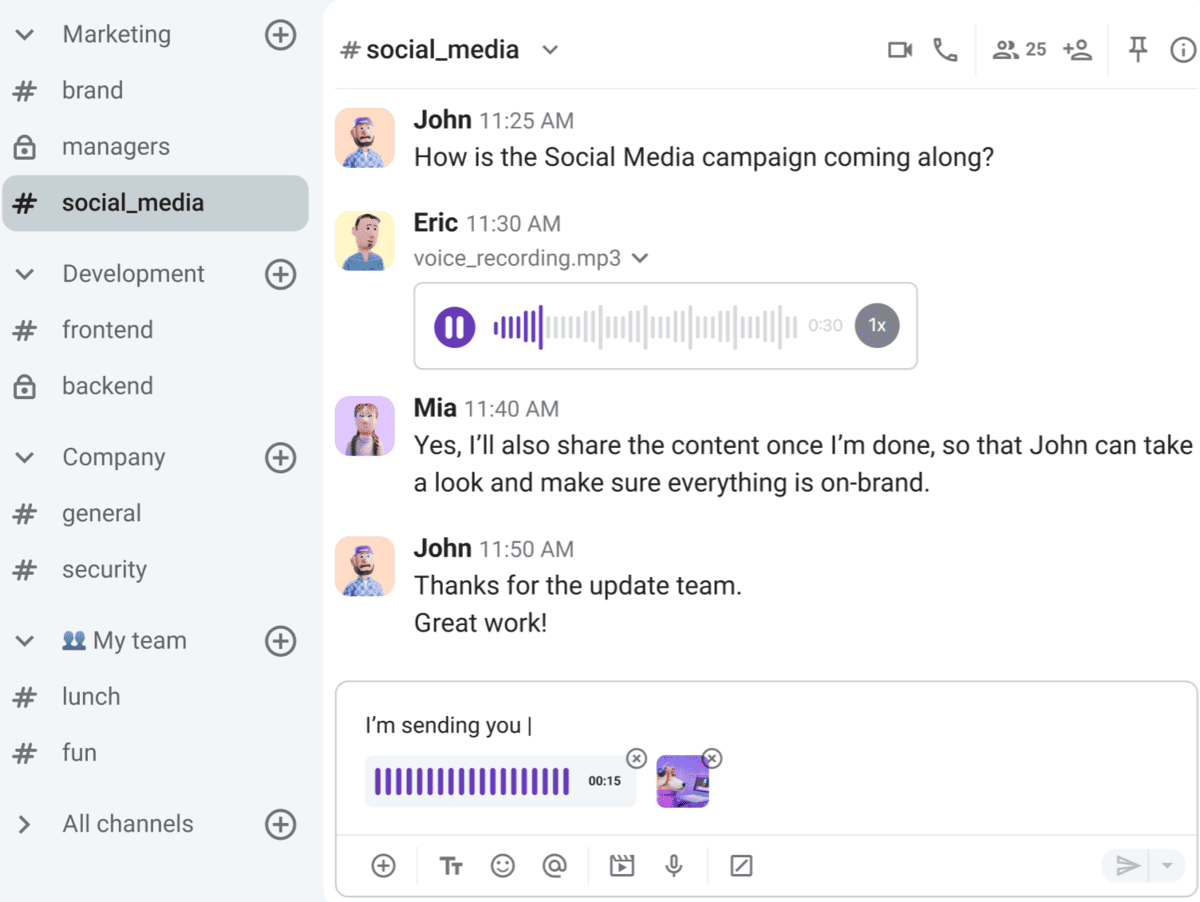
For example, when you post a major update in the #announcements channel, team members get firsthand news immediately — and you get ahead of the rumor mill and fill the information vacuum.
Work in channels with no restrictions
You don’t need to overexplain yourself the way you would in an email. To ensure your message contains the necessary context, you can simply attach a:
- Video file,
- Image,
- Screen recording, or
- PDF.
With all this transparency imbued in your messages, your team will immediately understand what’s going on and why it matters. And, for any additional questions or comments, there are threads.
#2 Use threads to build trust
You can further organize channels using threads. Not only do they group together all related messages, but they also allow you to easily add information you may have originally left out.

This openness and responsiveness helps build trust while giving you the opportunity to directly observe the grapevine. Instead of resorting to other means of communication, employees can now use threaded messages to express their:
- Concerns,
- Inquiries, and
- Feedback.
That means you can follow the shift of employee sentiment without playing catch-up. Address points of employee interest as soon as you can, and keep forging a communication-first culture.
Organize conversations with threads
#3 Use unlimited message history to create a single source of truth
We’ve already mentioned transparency as one of the foundational pillars of collaborative communication. However, when transparency disintegrates, grapevine communication takes the spotlight.
For this reason, it’s essential to establish a single source of truth — a digital headquarters that provides teams with information in real time, without forcing them to comb through multiple apps and folders.
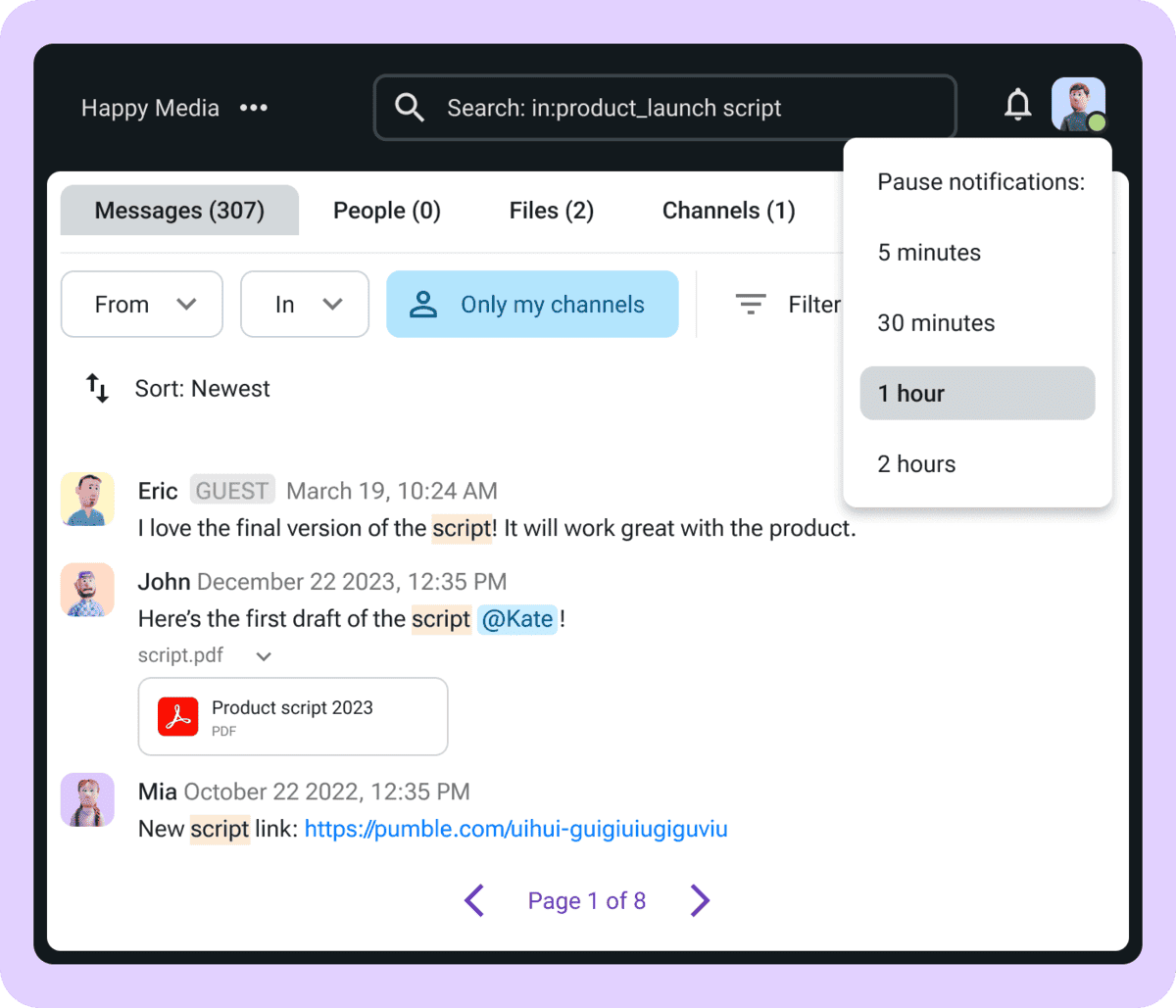
Access unlimited message history
That’s why working in Pumble makes sense for remote and hybrid teams. Each sent message and shared file instantly becomes part of your searchable database.
This means that whenever you need to retrieve information — regardless of when it was originally shared — a few keywords will guide you to it. This ease of use ensures that every employee has full access to key decisions, documents, and processes, which promotes a culture of collaboration and transparency.
In fact, transparency matters just as much (if not more) when it comes to building strong client relationships.
Pumble’s guest access feature makes it easy for organizations to invite clients, customers, and external collaborators aboard the virtual workspace. After modifying the level of access a guest has, you can create a separate channel that serves as a central knowledge base for your client or customer, outlining:
- Project updates,
- Service agreements,
- Campaign progress, and more.

Upgrade external collaboration today
Either way, whether you’re setting up an internal archive or a customer-facing database, you’ll need a platform that makes all your content searchable and available, forever.
Take control of the grapevine with Pumble
When you spend most of your time combating rumors and gossip, it seems impossible to focus on improving communication outcomes. Fortunately, Pumble can support you every step of the way, its features helping remove obstacles as you go.
Turn idle chit chat into productive conversations.

